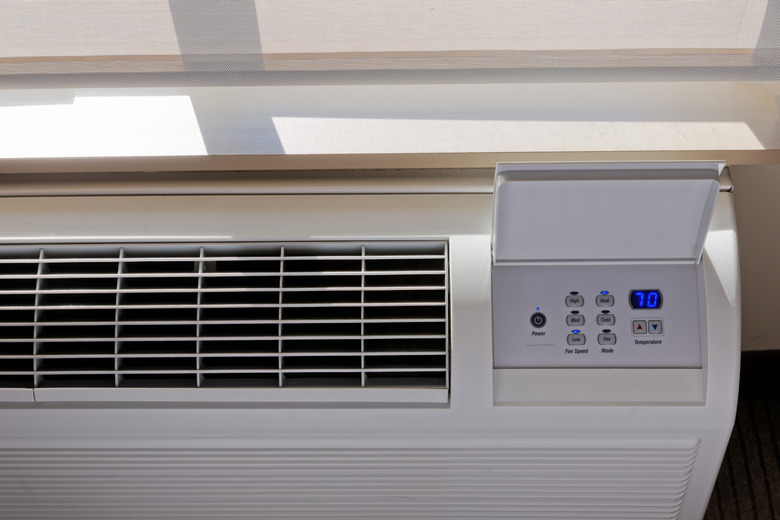How Does A Through-The-Wall Air Conditioner Work?
Through-the-wall air conditioners are a cooling option for buildings that do not have central air conditioning installed. Most units are designed to cool only one room, though some larger units may be able to cool additional rooms as well. No matter how large the unit, the ability to cool additional rooms is limited because the vent that blows cool air is only in one room. A wall air conditioner is different than a window air conditioner in several significant ways.
Tip
A through-the-wall unit works like a window unit except it's placed inside a frame in a hole cut through the wall. It leaves your windows free for other uses and doesn't stick out as far as a window unit.
Wall Unit vs. Window Unit
Wall Unit vs. Window Unit
Through-the-wall air conditioners look similar to window units, but they have differences in their setup and aren't interchangeable. The major difference between the two is that the vents are on the back of the wall unit instead of the sides like a window unit.
A through-the-wall unit doesn't hang out of the wall as much a window unit hangs out of the window. The back of the rear unit on a wall AC either sits flush with the exterior wall or hangs out minimally.
The installation of a wall unit is more labor intensive and is usually considered more permanent than a window unit is. Window units install and uninstall quickly, and they can be used in different windows.
Advantages of a Wall Unit
Advantages of a Wall Unit
One significant advantage that a wall unit has over a window unit is that it doesn't use up window space. When a window unit is installed, the window becomes unusable. With a wall unit, the window can still be used. This is especially useful if a room only has one window. By using a wall unit, you leave the window available as another escape route in case of a fire or emergency.
Since wall units stay in place year-round, you don't have to mess with installation every year. Once it's installed, it stays in place. It's important to insulate around the unit well to keep it as energy efficient as possible and to help save money on cooling and heating bills.
Through-the-Wall Air Conditioner Installation
Through-the-Wall Air Conditioner Installation
Through-the-wall air conditioners should be installed by a professional or a person that is very handy. A hole must be cut in the wall to install a wall unit and needs to be the precise size to ensure the unit to fit snugly. For weatherproofing reasons, space around the unit should be minimal. The hole also needs to avoid plumbing and electrical lines that run through the wall
Each air conditioner comes with a manual that lists the size the hole in the wall should be. A metal sleeve is placed inside the hole in the wall. The sleeve comes with the wall unit and provides structural support in the wall for the air conditioner.
After the air conditioner is installed into the sleeve in the wall, it is plugged into the nearest electrical outlet. Weatherproof stripping is put around the air conditioner to prevent outside air and water from entering the building.
How a Wall Unit Works
How a Wall Unit Works
A through-the-wall air conditioner works like other air conditioners by sucking hot air from the room into the unit. The hot air that enters the unit is brought over the air conditioning condenser and cooled. The cooled air is pushed back into the room. The motor that runs the unit produces hot air. The air conditioner pushes the hot air from the motor out through the vents in the back of the unit so that it doesn't heat the room.
Unit Installation Tips
Unit Installation Tips
Before purchasing the air conditioner, check the specifications on wall depth. Different models of air conditioners are different sizes. You want to make sure that the unit will fit in your wall. Some walls are too thick for some units.
The hole in the wall should be cut so that the air conditioner sits straight and level, avoiding any plumbing or electrical lines in the wall. If the unit sits at a tilt, it may not run properly. You'll need to cut through studs to fit the air conditioner, so use a stud finder to locate the studs and position it to cut through as few studs as possible. The frame you create for the air conditioner should attach to those cut studs for support.
